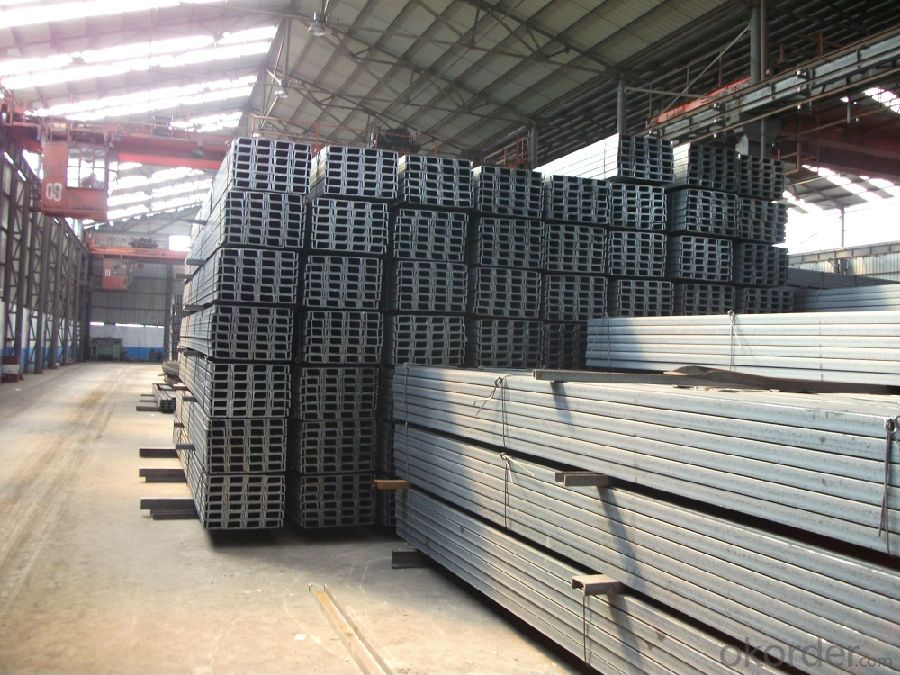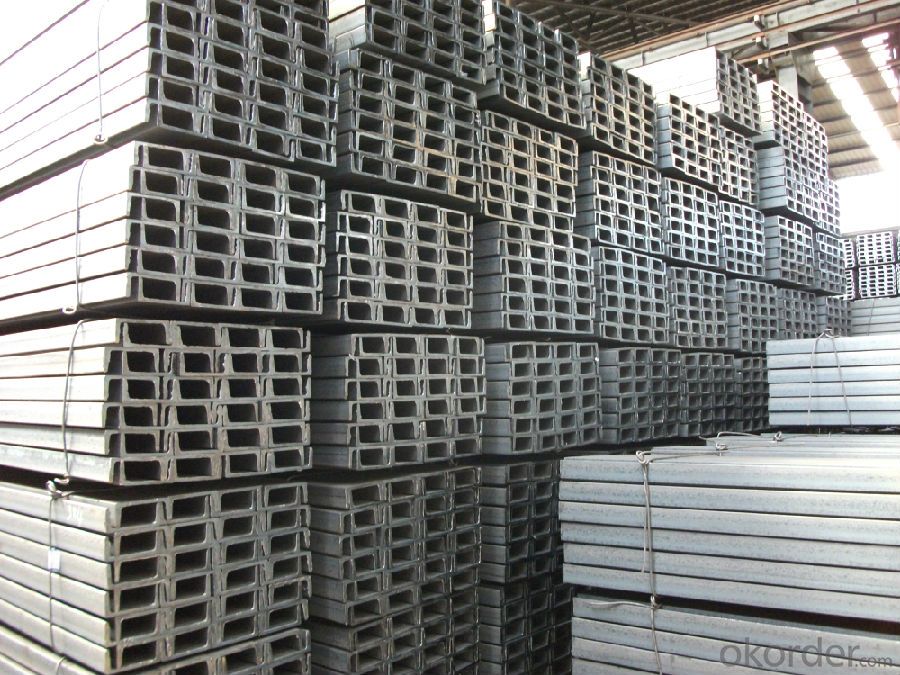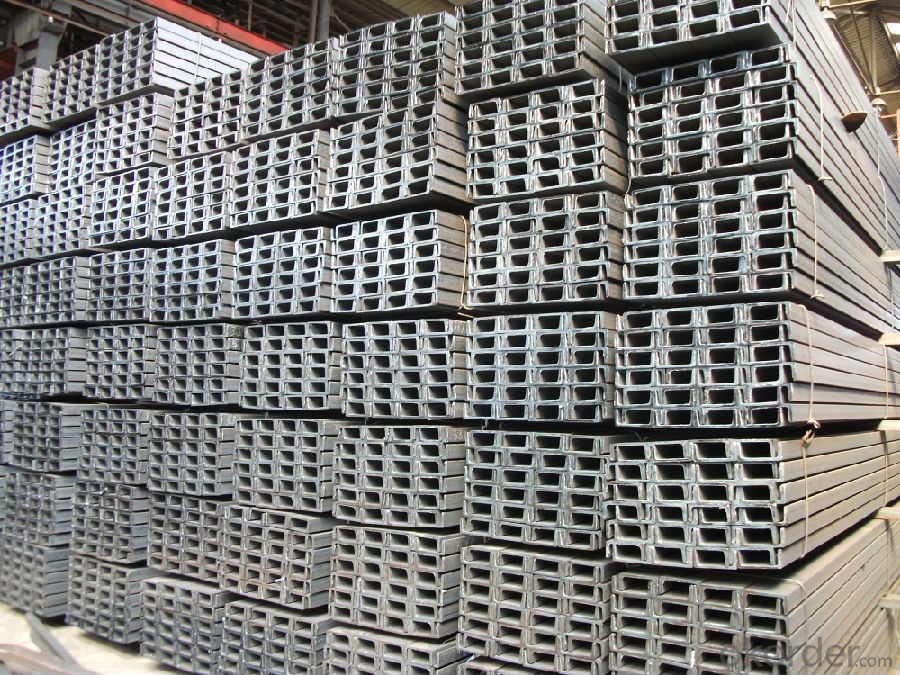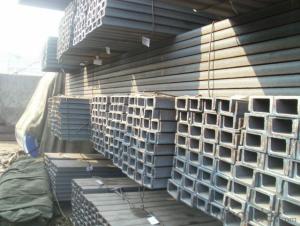U Channel Hot Rolled Steel Made In China GB JIS EN DIN
- Loading Port:
- Tianjin
- Payment Terms:
- TT OR LC
- Min Order Qty:
- 50 m.t.
- Supply Capability:
- 40000 m.t./month
OKorder Service Pledge
OKorder Financial Service
You Might Also Like
Item specifice
Product Description:
OKorder is offering U Channel Hot Rolled Steel Made In China GB JIS EN DIN at great prices with worldwide shipping. Our supplier is a world-class manufacturer of steel, with our products utilized the world over. OKorder annually supplies products to European, North American and Asian markets. We provide quotations within 24 hours of receiving an inquiry and guarantee competitive prices.
Product Applications:
U Channel Hot Rolled Steel Made In China GB JIS EN DIN are ideal for structural applications and are widely used in the construction of buildings and bridges, and the manufacturing, petrochemical, and transportation industries.
Product Advantages:
OKorder's U Channel Hot Rolled Steel Made In China GB JIS EN DIN are durable, strong, and resist corrosion.
Main Product Features:
· Premium quality
· Prompt delivery & seaworthy packing (30 days after receiving deposit)
· Corrosion resistance
· Can be recycled and reused
· Mill test certification
· Professional Service
· Competitive pricing
Product Specifications:
Standard Applied: GB Standard, EN Standard(UPN), JIS Standard
Sizes: 50mm to 300mm
Material Grade: Q235B, Q345B, S235JR, SS400, ASTM A36
As shown in the figure:
JIS U CHANNEL | Standard h | Sectional b | Dimension s | t | Mass: Kg/m |
(mm) | (mm) | (mm) | (mm) | ||
50x25 | 50 | 25 | 3.0 | 6.00 | 2.37 |
75X40 | 75 | 40 | 3.8 | 7.00 | 5.30 |
75X40 | 75 | 40 | 4.0 | 7.00 | 5.60 |
75X40 | 75 | 40 | 4.5 | 7.00 | 5.85 |
75X40 | 75 | 40 | 5.0 | 7.00 | 6.92 |
100X50 | 100 | 50 | 3.8 | 6.00 | 7.30 |
100X50 | 100 | 50 | 4.2 | 6.00 | 8.03 |
100X50 | 100 | 50 | 4.5 | 7.50 | 8.97 |
100X50 | 100 | 50 | 5.0 | 7.50 | 9.36 |
125X65 | 125 | 65 | 5.2 | 6.80 | 11.66 |
125X65 | 125 | 65 | 5.3 | 6.80 | 12.17 |
125X65 | 125 | 65 | 5.5 | 8.00 | 12.91 |
125X65 | 125 | 65 | 6.0 | 8.00 | 13.40 |
150x75 | 150 | 75 | 5.5 | 7.30 | 14.66 |
150x75 | 150 | 75 | 5.7 | 10.00 | 16.71 |
150x75 | 150 | 75 | 6.0 | 10.00 | 17.90 |
150x75 | 150 | 75 | 6.5 | 10.00 | 18.60 |
1.We are able to provide channel steel of top quality at attractive price.
2.Our products of channel steel have passed ISO9001:2008 Quality Management System Certification.
Package & Delivery of Channel Steel:
The steel u channel will be packed in bundle with steel wire at each end of every bundle and color marking in order to help the customer to recognize his goods more easily at sight.
And steel u channel could be loaded into 20ft or 40ft container, or by bulk cargo. If the weight of each bundle reaches less than 3.5 mt, the loading by break bulk cargo should be choosed. When the weight of each bundle reaches less than 3mt, the loading by container should be choosed.
As for the transportaion from mill to loading port, the truck will be usually used. And the maximum quantity for each truck is 40mt.
All in all, we could do in accordance with customer's request.
FAQ:
Q1: Why buy Materials & Equipment from OKorder.com?
A1: All products offered byOKorder.com are carefully selected from China's most reliable manufacturing enterprises. Through its ISO certifications, OKorder.com adheres to the highest standards and a commitment to supply chain safety and customer satisfaction.
Q2: How do we guarantee the quality of our products?
A2: We have established an advanced quality management system which conducts strict quality tests at every step, from raw materials to the final product. At the same time, we provide extensive follow-up service assurances as required.
Q3: How soon can we receive the product after purchase?
A3: Within three days of placing an order, we will begin production. The specific shipping date is dependent upon international and government factors, but is typically 7 to 10 workdays.
Q4: What makes stainless steel stainless?
A4: Stainless steel must contain at least 10.5 % chromium. It is this element that reacts with the oxygen in the air to form a complex chrome-oxide surface layer that is invisible but strong enough to prevent further oxygen from "staining" (rusting) the surface. Higher levels of chromium and the addition of other alloying elements such as nickel and molybdenum enhance this surface layer and improve the corrosion resistance of the stainless material.
Q5: Can stainless steel rust?
A5: Stainless does not "rust" as you think of regular steel rusting with a red oxide on the surface that flakes off. If you see red rust it is probably due to some iron particles that have contaminated the surface of the stainless steel and it is these iron particles that are rusting. Look at the source of the rusting and see if you can remove it from the surface.
Images:



- Q:Can steel channels be used for balcony supports?
- Yes, steel channels can be used for balcony supports. Steel channels are commonly used in construction due to their strength and durability. They provide a sturdy and reliable support system, making them suitable for balcony structures.
- Q:How do steel channels perform in high-traffic areas?
- Steel channels perform well in high-traffic areas due to their durability and strength. They can withstand heavy loads and provide excellent support, making them ideal for use in areas with high foot or vehicle traffic. Additionally, steel channels have a long lifespan and require minimal maintenance, making them a reliable choice for high-traffic areas.
- Q:How do steel channels contribute to the overall aesthetics of a structure?
- Steel channels can contribute to the overall aesthetics of a structure by providing a sleek and modern appearance. Their clean lines and minimalistic design can enhance the visual appeal of a building, giving it a contemporary and industrial look. Additionally, steel channels can be used creatively to create unique architectural features, such as framing windows or creating transitions between different materials.
- Q:Can steel channels be used in DIY projects?
- Yes, steel channels can be used in DIY projects. Steel channels are versatile and strong, making them suitable for various applications such as building structures, shelving units, and furniture. They can be easily welded, cut, or drilled to fit specific project requirements, making them a popular choice among DIY enthusiasts and professionals alike.
- Q:How do steel channels contribute to the overall acoustics of a building?
- Steel channels can have a significant impact on the overall acoustics of a building. These channels are often used as structural components in the construction of walls, ceilings, and floors. The way these channels are installed and connected in a building can affect how sound travels through the space. One way steel channels contribute to the acoustics of a building is by providing a rigid structure that helps control sound transmission. When properly installed, steel channels can reduce the transfer of sound vibrations between different areas of the building. This is particularly important in spaces where privacy and noise control are essential, such as offices, conference rooms, or residential units. Additionally, steel channels can be used to create acoustic isolation between different rooms or floors. By suspending ceilings or creating floating floors using steel channels, vibrations and impact noise can be minimized. This is especially crucial in spaces where activities like music recording, theaters, or classrooms take place, as it helps prevent unwanted noise from traveling between rooms. Moreover, steel channels can enhance the sound quality within a space by providing a solid mounting surface for acoustical treatments such as sound-absorbing panels, diffusers, or bass traps. These treatments can be strategically placed on the steel channels to improve the overall clarity and balance of sound within a room, reducing echoes and reverberations. In summary, steel channels play a crucial role in the overall acoustics of a building by controlling sound transmission, providing acoustic isolation, and enabling the integration of acoustical treatments. Properly utilizing steel channels in the construction process can help create a comfortable, functional, and acoustically optimized environment for various applications.
- Q:How do steel channels contribute to sustainable design?
- Steel channels contribute to sustainable design in several ways. Firstly, they are made from recycled steel, reducing the demand for virgin materials and minimizing the environmental impact of mining and extraction. Additionally, steel channels have a long lifespan and are highly durable, requiring minimal maintenance and replacements over time. This reduces waste and the need for frequent replacements, thus promoting resource conservation. Furthermore, steel channels can be easily disassembled and reused in other projects, enhancing their sustainability and reducing construction waste. Lastly, steel channels have high strength-to-weight ratio, allowing for efficient designs with lighter structures, resulting in reduced material consumption and transportation emissions. Overall, steel channels play a significant role in sustainable design by promoting resource conservation, waste reduction, and energy efficiency.
- Q:Are there any limitations to using steel channels in construction?
- Yes, there are limitations to using steel channels in construction. Some of the limitations include: 1. Weight: Steel channels can be quite heavy, which can pose challenges during transportation and installation. It may require specialized equipment and additional manpower to handle and install. 2. Cost: Steel channels can be relatively expensive compared to other construction materials. The cost of steel, especially if it is of high quality, can significantly impact the overall project budget. 3. Corrosion: Steel channels are prone to corrosion, especially in humid or coastal areas. If not properly protected or maintained, they can rust and deteriorate over time, compromising their structural integrity. 4. Thermal conductivity: Steel has high thermal conductivity, meaning it can transfer heat quickly. This can result in poor insulation properties and increased energy consumption for cooling or heating purposes. 5. Fire resistance: While steel is a non-combustible material, it loses strength and can deform under high temperatures. Without proper fireproofing measures, steel channels may not provide sufficient fire resistance, which can jeopardize the safety of the structure. 6. Design limitations: Steel channels are available in a variety of sizes and shapes, but there may still be limitations in terms of design flexibility. Complex or intricate designs may be more challenging or costly to achieve using steel channels. 7. Environmental impact: The production of steel channels requires significant energy and resources, which can have a negative environmental impact. Additionally, steel is not a renewable resource, and its extraction can contribute to deforestation and habitat destruction. It is important to consider these limitations and evaluate alternative materials or design solutions when planning a construction project to ensure the best possible outcomes in terms of cost, safety, and sustainability.
- Q:Are steel channels suitable for the power generation manufacturing industry?
- Yes, steel channels are suitable for the power generation manufacturing industry. Steel channels are commonly used in the manufacturing of power generation equipment such as turbines, generators, and transformers. The strong and durable nature of steel makes it an ideal material for supporting heavy loads and withstanding the high temperatures and pressures often encountered in power generation processes. Additionally, steel channels can be easily fabricated and customized to meet the specific design requirements of power generation equipment. They provide stability, structural integrity, and reliability, making them a suitable choice for the power generation manufacturing industry.
- Q:How do steel channels perform under dynamic loads?
- Steel channels are known for their high strength and load-bearing capacity, making them well-suited for handling dynamic loads. When subjected to dynamic loads, such as vibrations, impacts, or fluctuating forces, steel channels exhibit excellent performance and durability. The structural design of steel channels allows them to effectively distribute dynamic loads throughout their length, preventing localized stress concentrations. This characteristic minimizes the risk of fatigue failure, which is crucial in applications where repeated loading occurs. Steel channels also possess good stiffness, which helps to maintain their shape and integrity under dynamic loads. This stiffness allows them to resist bending, twisting, or deforming, ensuring the overall stability and safety of the structure. Additionally, steel channels are highly ductile, meaning they can withstand significant deformation without fracturing. This ductility is essential in absorbing and dissipating energy during dynamic loading events, such as impacts or earthquakes, reducing the risk of catastrophic failure. Furthermore, steel channels are often used in conjunction with other structural components, such as bolts, welds, or connectors, to enhance their load-bearing capacity. The combination of steel channels with these reinforcements further improves their performance under dynamic loads by increasing their resistance to shear, torsion, and bending forces. In summary, steel channels are well-suited for handling dynamic loads due to their high strength, excellent load distribution capabilities, stiffness, ductility, and compatibility with reinforcements. These qualities make them a reliable choice for various applications that require withstanding dynamic forces, ensuring the durability and safety of the structures they are used in.
- Q:How do steel channels contribute to the overall safety of a structure during earthquakes?
- Steel channels contribute to the overall safety of a structure during earthquakes by providing additional structural support and resistance to lateral forces. They help distribute the seismic energy more evenly throughout the structure, preventing localized damage and potential collapse. The channels act as bracing elements, increasing the stiffness and rigidity of the building, which reduces the chances of structural failure during seismic events.
1. Manufacturer Overview |
|
|---|---|
| Location | |
| Year Established | |
| Annual Output Value | |
| Main Markets | |
| Company Certifications | |
2. Manufacturer Certificates |
|
|---|---|
| a) Certification Name | |
| Range | |
| Reference | |
| Validity Period | |
3. Manufacturer Capability |
|
|---|---|
| a)Trade Capacity | |
| Nearest Port | |
| Export Percentage | |
| No.of Employees in Trade Department | |
| Language Spoken: | |
| b)Factory Information | |
| Factory Size: | |
| No. of Production Lines | |
| Contract Manufacturing | |
| Product Price Range | |
Send your message to us
U Channel Hot Rolled Steel Made In China GB JIS EN DIN
- Loading Port:
- Tianjin
- Payment Terms:
- TT OR LC
- Min Order Qty:
- 50 m.t.
- Supply Capability:
- 40000 m.t./month
OKorder Service Pledge
OKorder Financial Service
Similar products
New products
Hot products
Related keywords




























